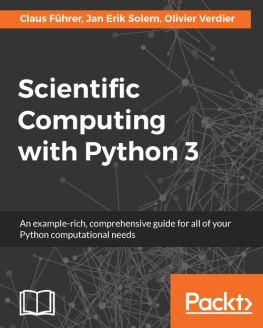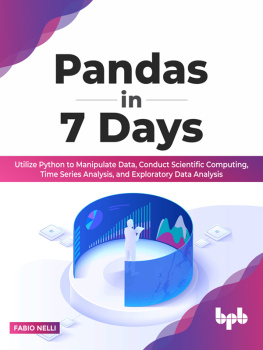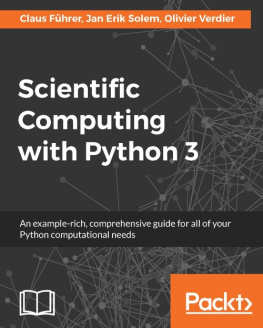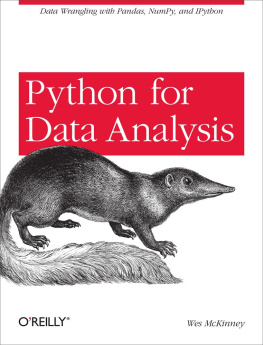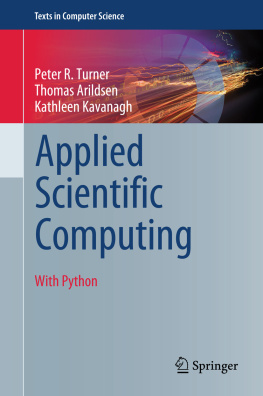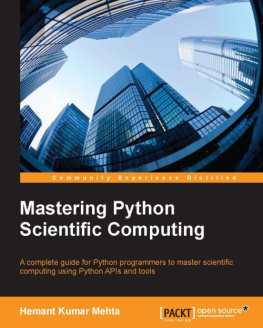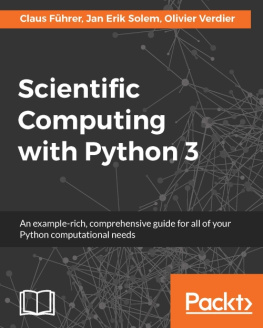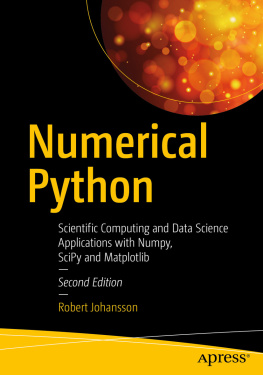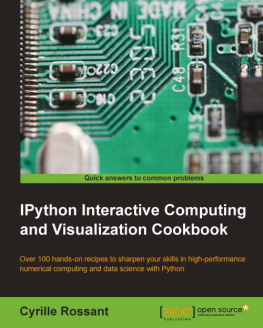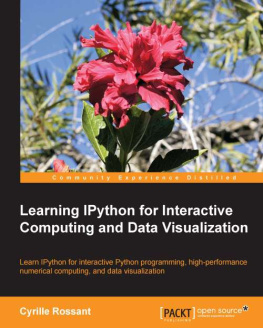Claus Führer - Scientific Computing with Python
Here you can read online Claus Führer - Scientific Computing with Python full text of the book (entire story) in english for free. Download pdf and epub, get meaning, cover and reviews about this ebook. year: 2021, publisher: Packt Publishing, genre: Home and family. Description of the work, (preface) as well as reviews are available. Best literature library LitArk.com created for fans of good reading and offers a wide selection of genres:
Romance novel
Science fiction
Adventure
Detective
Science
History
Home and family
Prose
Art
Politics
Computer
Non-fiction
Religion
Business
Children
Humor
Choose a favorite category and find really read worthwhile books. Enjoy immersion in the world of imagination, feel the emotions of the characters or learn something new for yourself, make an fascinating discovery.

- Book:Scientific Computing with Python
- Author:
- Publisher:Packt Publishing
- Genre:
- Year:2021
- Rating:5 / 5
- Favourites:Add to favourites
- Your mark:
- 100
- 1
- 2
- 3
- 4
- 5
Scientific Computing with Python: summary, description and annotation
We offer to read an annotation, description, summary or preface (depends on what the author of the book "Scientific Computing with Python" wrote himself). If you haven't found the necessary information about the book — write in the comments, we will try to find it.
Scientific Computing with Python — read online for free the complete book (whole text) full work
Below is the text of the book, divided by pages. System saving the place of the last page read, allows you to conveniently read the book "Scientific Computing with Python" online for free, without having to search again every time where you left off. Put a bookmark, and you can go to the page where you finished reading at any time.
Font size:
Interval:
Bookmark:
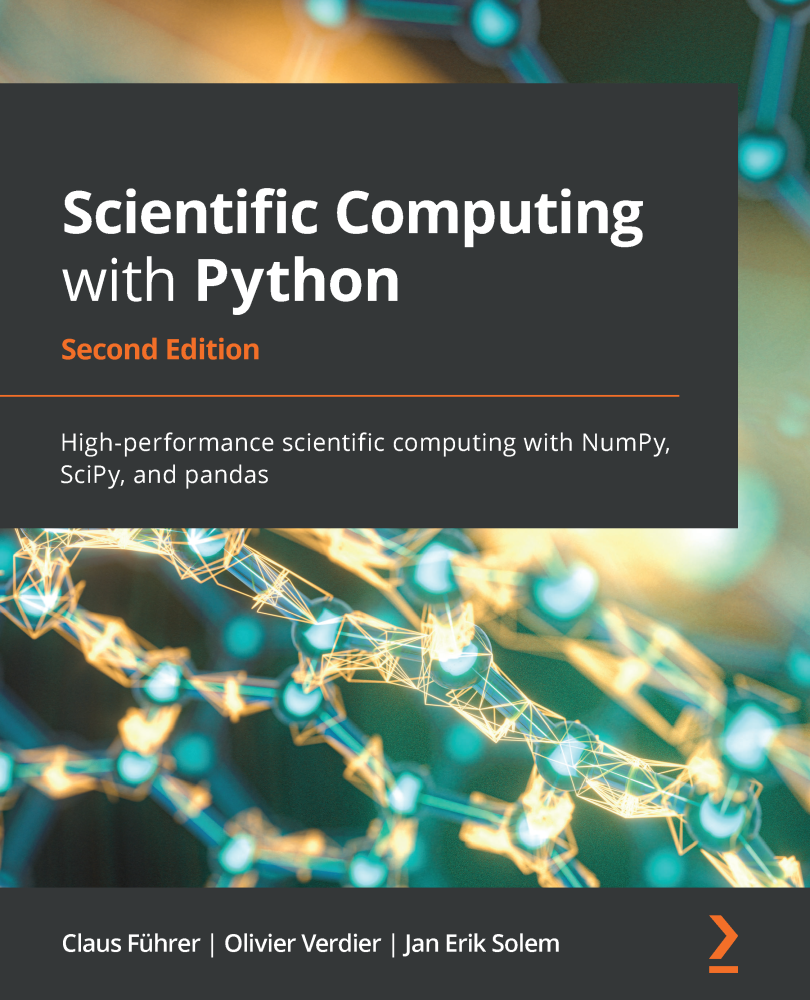
Second Edition
Jan Erik Solem

Second Edition
Copyright 2021 Packt Publishing
All rights reserved. No part of this book may be reproduced, stored in a retrieval system, or transmitted in any form or by any means, without the prior written permission of the publisher, except in the case of brief quotations embedded in critical articles or reviews.
Every effort has been made in the preparation of this book to ensure the accuracy of the information presented. However, the information contained in this book is sold without warranty, either express or implied. Neither the authors nor Packt Publishing or its dealers and distributors will be held liable for any damages caused or alleged to have been caused directly or indirectly by this book.
Packt Publishing has endeavored to provide trademark information about all of the companies and products mentioned in this book by the appropriate use of capitals. However, Packt Publishing cannot guarantee the accuracy of this information.
Group Product Manager: Kunal Parikh
Publishing Product Manager: Ali Abidi
Senior Editor: Mohammed Yusuf Imaratwale
Content Development Editor: Sean Lobo
Technical Editor: Manikandan Kurup
Copy Editor: Safis Editing
Project Coordinator: Aparna Ravikumar Nair
Proofreader: Safis Editing
Indexer: Rekha Nair
Production Designer: Joshua Misquitta
First published: December 2016
Second edition: July 2021
Production reference: 1180621
Published by Packt Publishing Ltd.
Livery Place
35 Livery Street
Birmingham
B3 2PB, UK.
ISBN 978-1-83882-232-3
www.packt.com
ContributorsClaus Fhrer is a professor of scientific computations at Lund University, Sweden. He has an extensive teaching record that includes intensive programming courses in numerical analysis and engineering mathematics across various levels in many different countries and teaching environments. Claus also develops numerical software in research collaboration with industry and received Lund University's Faculty of Engineering Best Teacher Award in 2016.
Olivier Verdier began using Python for scientific computing back in 2007 and received a Ph.D. in mathematics from Lund University in 2009. He has held post-doctoral positions in Cologne, Trondheim, Bergen, and Ume and is now an associate professor of mathematics at Bergen University College, Norway.
Jan Erik Solem is a Python enthusiast, former associate professor, and computer vision entrepreneur. He co-founded several computer vision startups, most recently Mapillary, a street imagery computer vision company, and has worked in the tech industry for two decades. Jan Erik is a World Economic Forum technology pioneer and won the Best Nordic Thesis Award 2005-2006 for his dissertation on image analysis and pattern recognition. He is also the author of Programming Computer Vision with Python.
Helmut Podhaisky works in the Institute of Mathematics at the Martin Luther University Halle-Wittenberg, where he teaches mathematics and scientific computing. He has co-authored a book on numerical methods for time integration and several papers on numerical methods. For work and fun, he uses Python, Julia, Mathematica, and Rust.
AcknowledgementWe want to acknowledge the competent and helpful comments and suggestions by Helmut Podhaisky, Halle University, Germany. To have such a partner in the process of writing a book is big luck and chance for the authors.
A book has to be tested in teaching. And here, we had fantastic partners: the teaching assistants from the course "Berkningsprogramering med Python" during the years, especially, Najmeh Abiri, Christian Andersson, Peter Meisrimel, Azahar Monge, Fatemeh Mohammadi, Tony Stillfjord, Peter Meisriemel, Lea Versbach, Sadia Asim and Anna-Mariya Otsetova, Lund University.
A lot of input to the book came from a didactic project in higher education leading to a Ph.D. thesis by Dara Maghdid. Together with him, the material of the book was tested and commented on by students from Soran University in Kurdistan Region, Iraq.
Most of the examples in the new chapter on GUI's in this second edition were inspired by our colleague Malin Christersson. Co-teaching this course with her, Alexandros Sopasakis, Tony Stillfjord, and Robert Klfkorn were fun. Hopefully not only for the teaching team but also for our studentsundergraduates and Ph.D. students. Special thanks also to Anne-Maria Persson, friend, director of studies, and supporter of Python in mathematics and physics higher education.
A book has not only to be written, but it also has to be published, and in this process, Sean Lobo and Gebin George, Packt Publishing, were always constructive, friendly, and helpful partners bridging different time zones and often quite challenging text processing tools. They gave this book project momentum in its final stage to be completedeven under hard Covid19 work conditions.
Claus Fhrer, Jan-Erik Solem, Olivier Verdier , 2021
Python has tremendous potential in the scientific computing domain. This updated edition of Scientific Computing with Python features new chapters on graphical user interfaces, efficient data processing, and parallel computing to help you perform mathematical and scientific computing efficiently using Python.
This book will help you to explore new Python syntax features and create different models using scientific computing principles. The book presents Python alongside mathematical applications and demonstrates how to apply Python concepts in computing with the help of examples involving Python 3.8. You'll use pandas for basic data analysis to understand the modern needs of scientific computing and cover data module improvements and built-in features. You'll also explore numerical computation modules such as NumPy and SciPy, which enable fast access to highly efficient numerical algorithms. By learning to use the plotting module Matplotlib, you will be able to represent your computational results in talks and publications. A special chapter is devoted to SymPy, a tool for bridging symbolic and numerical computations. The book introduces also to the Python wrapper, mpi4py, for message passing parallel programming.
By the end of this Python book, you'll have gained a solid understanding of task automation and how to implement and test mathematical algorithms along within scientific computing.
This book is for students with a mathematical background, university teachers designing modern courses in programming, data scientists, researchers, developers, and anyone who wants to perform scientific computation in Python. The book evolved from 13 years of Python teaching in undergraduate science and engineering programs, as special industry in-house courses and specialization courses for high school teachers. The typical reader has the need to use Python in areas like mathematics, big data processings, machine learning and simulation. Therefore a basic knowledge of vectors and matrices as well of notions like convergence and iterative processes is beneficial.
Next pageFont size:
Interval:
Bookmark:
Similar books «Scientific Computing with Python»
Look at similar books to Scientific Computing with Python. We have selected literature similar in name and meaning in the hope of providing readers with more options to find new, interesting, not yet read works.
Discussion, reviews of the book Scientific Computing with Python and just readers' own opinions. Leave your comments, write what you think about the work, its meaning or the main characters. Specify what exactly you liked and what you didn't like, and why you think so.

